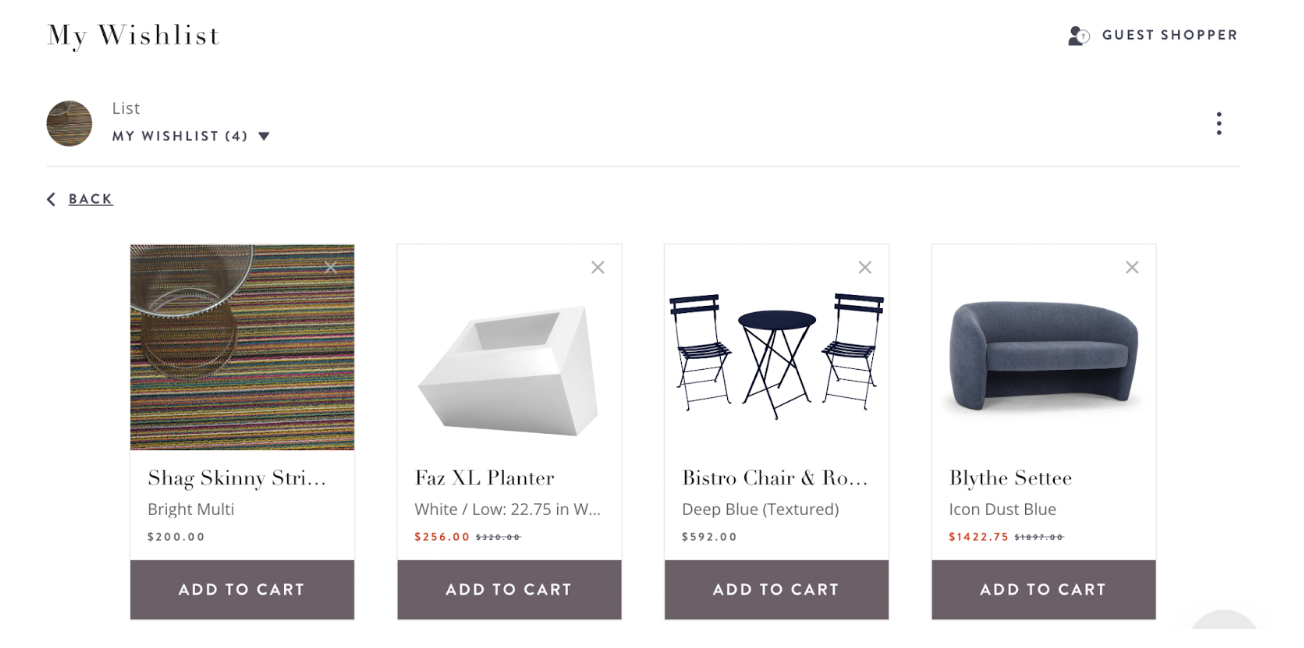Best Practices of Ecommerce Wishlist Tools
Wishlist tools, often overlooked, possess the potential to transform the shopping experience for both ecommerce store owners and customers alike. For stores without a wishlist, visitors are left to save items in their cart (which might refresh after a certain amount of time) or save the items in tabs in the browser. Not only is this a suboptimal experience, but it can skew your metrics like add to cart rates or cart abandonment rates. Wishlist tooling can be a helpful way for visitors to shop over time and keep interesting items saved for later browsing.
In this article, we will delve into:
- the significance of wishlist tools
- explore the considerations when choosing between building a custom wishlist feature or adopting a third-party tool
- examine the essential elements of a wishlist-equipped ecommerce website
- and provide illustrative scenarios to help you envision their implementation
The Importance of a Wishlist
A wishlist serves as a virtual space where customers can save items they are interested in purchasing at a later time. This simple yet powerful feature benefits both customers and ecommerce store owners in multiple ways. Although visitors could save items in a cart, many carts will refresh over time leading to customer frustration.
For customers, wishlists offer convenience and personalization. Shoppers often come across products they admire but may not be ready to buy immediately. Think of shopping for a future home purchase; you likely have many ideas for the layout and decoration, but you aren’t at that point where you need to buy items yet.
By adding items to a wishlist, visitors can easily revisit and evaluate their choices, eliminating the need to search for the products again. This creates a seamless shopping journey, enhancing customer satisfaction. Additionally, wishlists can serve as a form of self-expression and a way to curate one’s preferences, fostering a deeper engagement with your brand.

From the store owner’s perspective, wishlist tools are a goldmine of insights. They provide valuable data about customer preferences and popular products. This information can inform inventory management, marketing strategies, and the introduction of new products, ultimately driving sales and boosting revenue. Wishlists can also act as a lead generation tool, as customers often need to create accounts or log in to save items, providing you with an opportunity to nurture these leads through targeted marketing campaigns. Utilizing wishlist information can enhance the store experience, as you can now personalize a shopper’s view of the store based on items they’ve saved. This makes it more relevant to them, increasing the chance they find something they’d like to purchase.
Custom Wishlist vs. Third-Party Solution: Making the Right Choice
When considering the implementation of a wishlist feature, a crucial decision arises: whether to build a custom solution or utilize a third-party tool. Each approach has its pros and cons, and the decision should be based on factors such as your budget, technical capabilities, and long-term goals.
Building a Custom Wishlist Feature:
Pros
- Tailored to Your Needs
A custom wishlist can be designed to seamlessly integrate with your website’s aesthetics and functionalities. This means more ability to integrate with personalization tools, email marketing, etc. - Unique Features
You have the freedom to include custom features that set you apart from competitors, potentially enhancing the user experience. You won’t be forced into the features that a third party will offer.
Cons
- Resource-Intensive
Developing a custom feature requires time, money, and skilled developers. It is going to be a much longer process to develop, than to select and pay for a third-party app. - Maintenance and Updates
You’ll be responsible for the ongoing maintenance, updates, and bug fixes, which can be resource-draining. You’ll need to allocate a budget for future development work on a custom wishlist tool.
Adopting a Third-Party Wishlist Tool:
Pros
- Quick Integration
Third-party tools are typically easy to integrate, requiring minimal technical knowledge. - Cost-Effective
Initial costs are lower compared to custom development, and you benefit from ready-made features. - Continuous Improvements
Reputable third-party providers regularly update their tools, ensuring you’re always using the latest features.
Cons
- Limited Customization
While many third-party tools offer customization options, you might not achieve the same level of uniqueness as a custom solution. - Dependency
You’re reliant on the third-party provider’s service, which might change or discontinue in the future.
Essential Wishlist Features for Your Ecommerce Website
Regardless of whether you opt for a custom-built wishlist or a third-party solution, certain features are essential to ensure a seamless user experience and maximize the benefits for your ecommerce store:

- User-Friendly Interface
The wishlist tool should be easy to use and navigate, ensuring customers can effortlessly add, remove, and manage items. It’s important to extensively walk-through and QA a new wishlist tool to ensure there are no points of confusion or bugs that could prevent customers from using the tool. - Social Sharing
Integrate social sharing buttons to allow customers to share their wishlists with friends and family, potentially driving new traffic to your site or facilitating purchase decisions with partners or family members. - Real-Time Updates
Ensure that any changes made to an item’s availability, price, or stock status are reflected in real-time on the wishlist. - Notifications
Implement personalized notifications, such as price drops or restocked items, to keep customers engaged and informed. This is a great way to get visitors back to your store, as this information is very relevant to them. - Mobile Responsiveness
The wishlist tool must offer a seamless experience across all devices. Ideally you optimize the tool with mobile in mind first, as this is how the majority of your visitors will likely interact with your site. - Privacy and Security
Prioritize the security of customer data and allow users to control their privacy settings.
Wishlist Scenarios: Bringing the Concept to Life
Let’s explore a few scenarios to understand how wishlist tools can be applied effectively:
- Fashion-Forward
Imagine an online clothing store. A customer, Lexi, comes across a stunning dress but isn’t ready to purchase it. Instead of losing track of the item, she adds it to her wishlist. Later, the store sends her a notification about a limited-time discount on the dress. Sarah promptly buys it, delighted with the personalized offer. - Techie’s Wishlist
A tech-focused ecommerce site introduces a wishlist feature. Mark, a gadget enthusiast, adds a high-end smartphone and a smartwatch to his wishlist. The store utilizes this data to send Mark information about a bundle deal featuring both items at a reduced price, successfully upselling him. - Gift Registry
A specialty gift shop allows customers to create wishlists for special occasions. Lisa creates a wishlist for her upcoming wedding and shares it with her friends and family. This not only makes the gift-selection process easier for her loved ones but also introduces new customers to the store.
Elevate Your Ecommerce Experience with Wishlist Tools
In the ever-evolving ecommerce landscape, embracing innovative features like wishlist tools can set your store apart. By offering convenience, personalization, and valuable insights, wishlists enhance the customer experience and drive sales. The choice between a custom-built wishlist and a third-party tool depends on your unique circumstances, but both options can lead to positive outcomes. Remember to prioritize user-friendliness, responsiveness, and personalization when integrating a wishlist tool into your website. As you’ve seen through various scenarios, wishlists not only cater to customer needs but also open doors for strategic marketing initiatives.
In a world where customer engagement and satisfaction are paramount, a wishlist tool is more than just a feature; it’s a gateway to enhanced customer relationships and increased sales. It’s time to explore the world of wishlist tools and harness their potential to transform your store.
